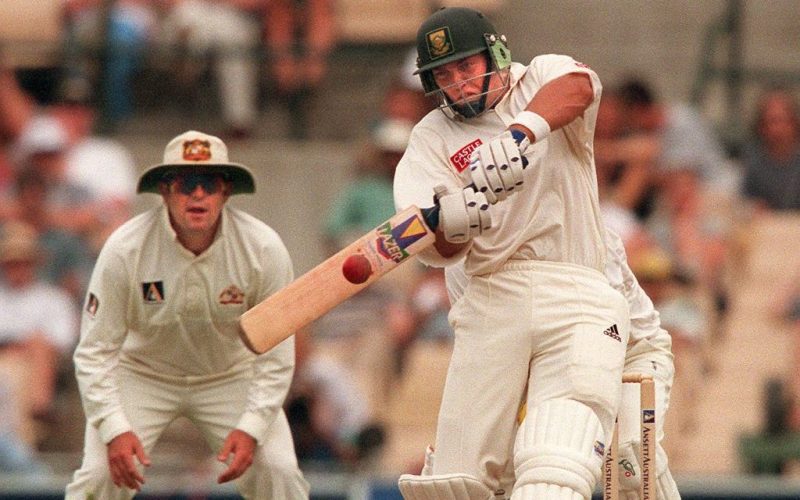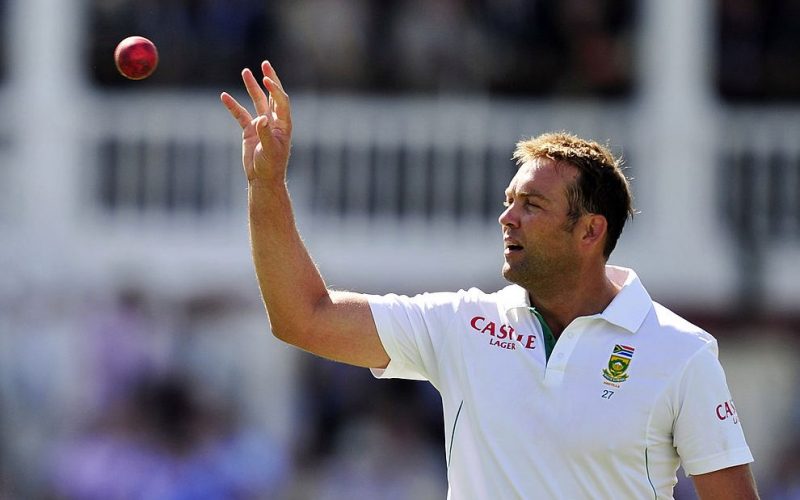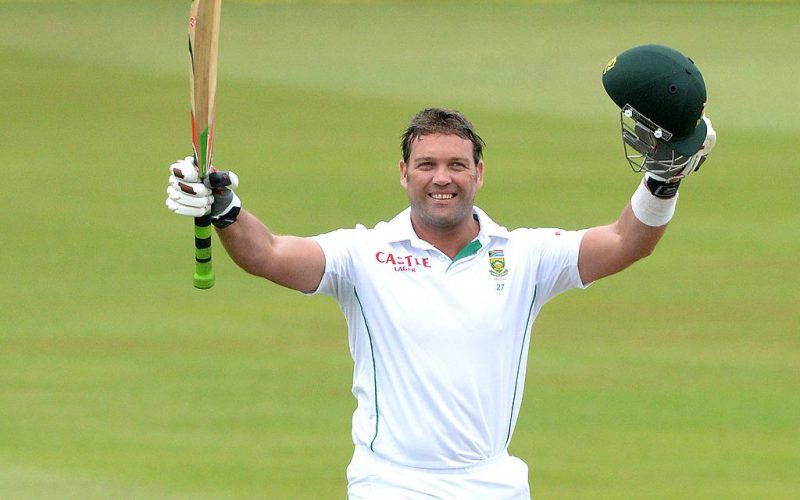The Big Five who defined the era of batsmanship: Jacques Kallis

@TelfordVice 10 minute read
In the same way that Sean Connery and Jack Nicholson, regardless of the characters they play, are always Sean Connery and Jack Nicholson, so Jacques Kallis is always Jacques Kallis, writes Telford Vice.
First published in 2014
Women have never struggled to make Shane Warne look silly. A torrid text here, a tabloid tale there, and the master is made merely mortal, mercilessly more often than not. But men, riddled as we are with our broken chromosomes and shot through with soft-boiled ego, are hopelessly ill-equipped to make Warne’s permanent tan and hair implants appear closer in life’s rear-view mirror than his sharp dress sense and dazzling smile. That’s women’s work.
However, we can take solace from the fact that none of us even more merely mortal men could possibly have played the “ball of the century” worse than dear old Mike Gatting. The indecision, the inability to move any of the required muscles in any of the required ways, the indelible shock frozen on the face – all of us who have picked up a bat along with our delusions of flannelled fooldom have, when facing far less threatening deliveries, been there, done that, and got the long, awkward silence from our teammates.
Warne, then, is the great leveller among men of cricket. He could, even now, way past his pomp, make any of us look eminently silly; be we Gatting, Gavaskar, Gooch, Gower or Gavin from down the pub.
What manner of man, then, is Jacques Kallis? Perhaps one more in touch with his feminine side than he would like to admit, because it took him a single innings to reduce Warne to just another frustrated bloke stuck behind a truck in the slow lane of life.
That said, it took quite some innings to put Warne in his place. A touch under six hours and 279 balls, only six of them dispatched to the boundary, was what Kallis needed to score 101 in the second innings of the 1997 Boxing Day Test at the MCG.
It was Kallis’ seventh Test and his first against an Australian team soaked in swagger, a side that had come to consider themselves – and to be considered by their opponents – as The Shit.

Kallis displayed great mix of resolve and grit to help South Africa salvage a draw at the MCG
They were the team of the Waughs, of Ponting, Healy and McGrath. They wore their greatness as if they had been born with it as standard, and they weren’t about to have it ignored by some kid barely two months past his 22nd birthday.
Clearly, no one had told Kallis exactly who he was up against. Or, if they had, he had chosen to do the unthinkable and treat the Australians as what they had spent years convincing the world they were not: just another cricket team.
Or is Kallis that rare thing, the player who is impervious to his environment, untouched and untouchable by those who would seek to get inside his head? In a word, bulletproof. Yes, he is.
Even Wisden, not given to metaphysical meandering, said so. Sort of. Cricket’s grandest book recorded that Kallis showed “an indifference to the sledging of the close fielders that left them wondering if he was deaf”.
Warne, in particular, could not accept the reality that crept up on Australia with each passing over that they could not rid themselves of Kallis. The leg-spinner huffed, he puffed, and he was certain he would blow Kallis’ house down any ball now. Except that he didn’t; not until there were only 24.4 overs left in the game.
That was when Warne bowled Kallis, via the edge, mind, to reduce South Africa to 229-5. He celebrated like a child who had been relieved of a troublesome tooth, not a warrior scenting victory.

Kallis in Tests: 13,289 runs, 292 wickets, 200 catches – a complete package
It had been a withering six hours for Warne, during which he had veered from tetchiness to tantrum and back. Soon enough afterwards he was the Warne we knew, loved, admired, respected and feared. But for those long hours under Melbourne’s unforgiving sun he was merely mortal, pulling gargoyle faces and screaming at the sky. When Gavin from down the pub succumbs to something similar we call him silly.
Kallis was 40 not out at stumps on the fourth day, which South Africa reached on 79-1 having faced 30 overs. The target, 381, was somewhere over the rainbow. The mission was to see out 92 overs on the final day, and that on a pitch that would have evoked tears of desert longing in the eyes of TE Lawrence.
Impossible? Not to Adam Bacher, who was 34 not out when the fifth day started. By then Bacher knew what Kallis was capable of, having toured Sri Lanka with him two years earlier as part of South Africa’s under-24 squad.
“He was definitely a freak,” Bacher said. “In extreme heat, I had watched him bowl very fast and then go and bat No. 3. That’s not normal.”
But a lush, languid Asian island is a far cry from the concrete jungle of the MCG, particularly in the heady hostility of a Boxing Day Test. This one alone was watched by a total of 160,182 people, almost all of them given to raking their throats raw with yells of, “Aussie! Aussie! Aussie!”
“That was huge pressure,” Bacher said. “Neither of us had played in front of a crowd a quarter of that size.”
What Bacher had come to understand, and what the crowd would know by the time hands were shaken and stumps were drawn with three wickets standing defiant, was that no one but Kallis wrote his scripts. And he only had to do so once – Kallis’ script never changed.
In the same way that Sean Connery and Jack Nicholson, regardless of the characters they play, are always Sean Connery and Jack Nicholson, so Jacques Kallis is always Jacques Kallis.
Nelson, stood stonily atop his column in Trafalgar Square, is more likely to lash out at a diarrhetic pigeon than Kallis is to allow anything or anyone to change his mind or his method. Kallis defied Newton’s third law – for him, there was no equal and opposite reaction to any action ranged against him. There was only what Kallis wanted to do, and he did it.
That applied even to his retirement from Test cricket. Announced on Christmas Day last year in a whimpering tweet from Cricket South Africa, it left no room for a farewell Test at Newlands.
“He would probably have preferred to, once the game was over and everyone had gone home, send a message saying, ‘That’s me; I’m done’,” Kallis’ great friend, Mark Boucher, said.
So Kallis’ last Test was against India at Kingsmead. He went out with a bang, scoring 115. A guard of honour when he came in to bat was followed by a lap of honour after the match. The latter was paused when Kallis accepted a beer handed across the boundary. In one of the more human gestures he has made in public, he downed it in one throaty gulp.

Kallis scored a match-winning hundred in his last Test against India, and with it inched past Dravid in the all-time leading run-scorers list
Clive Rice was unmoved. “I don’t understand how he can make a hundred and just walk away,” Rice fumed in the press. “If he had gone out for two ducks, I would understand. But not after a fantastic hundred. Why did he get out now? There is no such thing as bowing out while still at the top. If his eyes were giving up on him or the form was not there, I would understand.”
Not even Kallis could please all of the people all of the time. Once, during an ODI, after he had hit a perfectly decent delivery high, wide and handsome over the point boundary, Colin Bryden, easily the most unflappable, unwavering, and unmovable member of the South African cricket press corps for several decades, couldn’t help spluttering in a disbelieving squawk of vivid animation: “Y’know! This guy! He could hit a six whenever he feels like it!”
Bryden was right. We all knew it. But it was what he did not squawk that was more pertinent – why did Kallis not feel like hitting sixes more often, or at least, like, take a more attacking approach?
His most disappointing example of that deficiency came in South Africa’s 2007 World Cup match against Australia in St Kitts. Chasing 378 to win on a ground small enough to make some of the reporters present wonder with juvenile seriousness whether they could throw a ball from one sight-screen to the other on the full, Graeme Smith and AB de Villiers roared to 160 for the first wicket before de Villiers was run out in the 21st over. Then Smith retired hurt with cramp.
Kallis, who had replaced de Villiers at the crease, had his supporting cast that day in Herschelle Gibbs, Ashwell Prince, Boucher, Justin Kemp, Shaun Pollock and Andrew Hall. A year earlier, eight of the XI who played the match in St Kitts had helped chase down 434 to beat the Aussies at The Wanderers. That was more than enough licence to thrill, to squeeze the trigger and keep squeezing.
Instead, Kallis demurred all the way into the penthouse of his ivory tower, taking 63 balls to score 48 in a performance that looked more like his MCG century than what was required to win a high-scoring ODI. South Africa lost by 83 runs, a portent for them crashing to 27-5 on their way to a seven-wicket thrashing by Australia in the semi-finals.
Happily, for South Africans, Kallis’ aberrations were few. For his entire Test career, he was the rock his team clung to. It took Gary Kirsten to make his erstwhile teammates understand how to become the sum of their parts. That was after he was appointed coach in June, 2011. Until then – both before and after 22 years of apartheid-induced isolation – South Africa were, for the most part, chronic under-performers. Like Warne, but not like Warne, Kallis was their leveller; the man who kept them in the game and insulated them from ignominy.
Kallis’ role as a bowler was the mirror image of what he did with the bat. He was the unblinking assassin who tamed thunder and lightning, very, very frightening, and found the pace and bounce and cold blood-lust to take the wicket that must be taken.
As a fielder, he made no sense. How could it be that a man of such bulk and apparent languidness could stand at second slip with his hands resting on his knees one moment – as if watching a cloud of butterflies alight – and the next catch the uncatchable?
But it is as a batsman that Kallis will be remembered longest and best. The die for his career was cast in that 1997 Boxing Day Test. Often, like he did then, he stood between South Africa and defeat. Often, his was the most important wicket of the lot. Often, he had to protect it with his life. Too often, Kallis was sent out to bat for the team and the team alone, and not at all for himself.
He had not been born to this manner, but with quick cruelty he was given the tools to assume it. Kallis can seem like a man who had his childhood snuffed out. The death of his mother when he was but a tyke would have seen to that. His father raised him, instilled in him the wonder of the greatest game, and grew him and his sister up alone.
It is to Henry Kallis’ everlasting credit that he managed to preserve, somewhere in the imposing frame of one of the most dispassionate, together, prosaic players ever to step across a boundary, a flame of feminine softness. It flickers brightest when Kallis raises his face to where he believes his father lives on now, his salute for a century since Henry’s death in 2003.
We already know Kallis is a rare man. Could he be even more unusual than we think? Might not all of his chromosomes be broken?
First published in 2014

